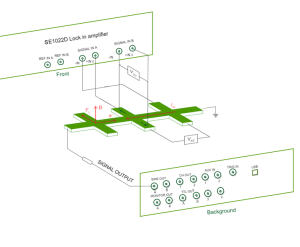[Application Introduction] SE1022D Dual-Channel Lock-in Amplifier Measuring Hall Effect
The Hall effect is a type of electromagnetic effect. When current passes through a semiconductor perpendicular to an external magnetic field, carriers are deflected, and an additional electric field is generated perpendicular to the direction of the current and the magnetic field, thereby generating a potential difference at both ends of the semiconductor. This phenomenon is the Hall effect. The Hall effect is widely used in material characterization and magnetic field sensing.
Material Characterization
In material characterization applications, the material is placed in a known magnetic field B. At the same time, the Hall voltage VXY (Figure 1), the voltage VXX through the sample, and the current IR through the material are measured. Based on these measurements, we can infer material properties such as carrier density, carrier polarity, carrier mobility, and material conductivity.
This technology can also be used to measure the quantum Hall effect and various derivative effects such as integer, fractional, spin, and reverse spin, thereby measuring new physical properties of two-dimensional electron gas (2DEG) materials.
Magnetic field sensing
When the material properties are known, the Hall effect can be used to infer the external magnetic field strength over a range of multiple orders of magnitude. Measurements can be performed by applying a DC voltage to the sample, but AC measurements are usually faster and more accurate. Other advantages of AC measurements include higher accuracy and sensitivity, and the ability to achieve a higher signal-to-noise ratio (SNR) over a larger measurement range.

Figure 1
As shown in Figure 1, the measurement requires two lock-in amplifiers. The Saluki SE1022D is a dual-channel lock-in amplifier with two independent and synchronized lock-in units. One lock-in amplifier can meet the dual-channel measurement requirements, greatly improving test efficiency. Moreover, the synchronization and consistency of the dual-channel lock-in amplifier are much better than two single-channel lock-in amplifiers.
(represented as LIA A channel in the figure) provides a constant AC voltage to induce a current in the sample. Usually, just place a current limiting resistor RL that is much larger than the sum of all other resistors in the circuit, and the current can be assumed to remain constant during the measurement. A more accurate measurement can be achieved by measuring the current through the sample. The SE1022D dual-channel lock-in amplifier A channel measures the Hall voltage VXY, while the SE1022D dual-channel lock-in amplifier B channel (represented as LIA B channel in the figure) measures the voltage VXX through the sample.



